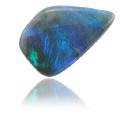.
A piece of clear crystal Quartz known as a Sceptor.
Dendritic Quartz. The stains are found in microscopic fissures that cause them to branch out like tree limbs or fern like inclusions. Of course in nature no two things are alike, making each gem one of a kind. Like most of the included quartz, the primary sources of Dendritic Quartz are Brazil and Africa, but some have been found in the western United Satates and Arkansas.
.
.
Rutilated Quartz. Rutile is a major ore of titanium, which is a metal used for high tech alloys. It often forms needle-like crystal inclusions inside the Quartz crystal. This form of quartz looks like small bars of imbedded gold. Rutile is a 6 on the Mohs scale whereas Quartz is a 7. Because of the difference in hardness between the two materials and because of the way rutile forms inside, this can be a difficult stone to attain a smooth surface without pits. Most Rutilated Quartz is found is Brazil, Pakistan, Kazakhstan, Madagascae, Brazil and several locations in the United States.
.
Tourmalinated Quartz. As pointed out many minerals may be found as inclusions in quartz. When Tourmaline is found within quartz, the quartz is known as "tourmalinated". Most of this variety of Quartz is found in Brazil but large pockets have also been found in California.
.
Here are some pictures of some other types of included Quartz.
Quartz with included Pyrite........ Quartz with included Gilalite
Lodolite is a term used for a varity of Quartz with included minerals from Minas Gerais, Brazil. The colorations and patterns come from three main types of minerals, Chlorite, Iron, and Calcite.
.
.





























